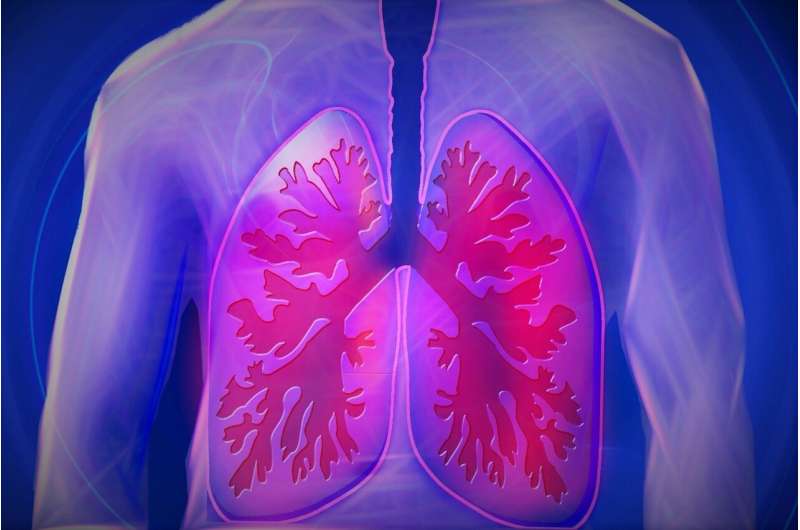This article has been reviewed according to Science X's editorial process and policies. Editors have highlighted the following attributes while ensuring the content's credibility:
fact-checked
peer-reviewed publication
trusted source
proofread
Researchers discover novel approach for rebuilding, regenerating lung cells

Researchers from the Center for Regenerative Medicine (CReM), a joint venture between Boston University and Boston Medical Center, have discovered a novel approach for engrafting engineered cells into injured lung tissue. These findings may lead to new ways for treating lung diseases, such as emphysema, pulmonary fibrosis and COVID-19.
The two studies describing the methodologies for engineering lung stem cells and transplanting them into injured experimental lungs without immunosuppression appear online in Cell Stem Cell.
For more than 20 years, the scientists leading this work have pursued a way to engraft cells into injured lung tissues with the goal of regenerating lung airways or alveoli. They suspected that for engraftment to be long-lived and functional it would be important to reconstitute the stem or progenitor "compartments" of the lung, also sometimes known as stem cell niches.
They concentrated on first developing methods for engineering each of the lung's stem or progenitor cells in the laboratory using pluripotent stem cells, and then developed methods for transplanting these cells into experimental mouse models with injured lungs.
In their study "Airway Stem Cell Reconstitution by Transplantation of Primary or Pluripotent Stem Cell-Derived Basal Cells," the CReM researchers focus on the lung airways. These airways are lined by an epithelium that has well described stem cells called "basal cells," which are responsible for maintaining these airways throughout life.
"By differentiating experimental model and human pluripotent stem cells into airway basal cells in the laboratory dish, we were then able to use these cells to reconstitute the stem cell compartment of the injured model airways in vivo (in living tissue). This resulted in life-long engraftment of the engineered basal cells in an immunocompetent model," explained corresponding author Darrell Kotton, MD, the David C. Seldin Professor of Medicine at Boston University Chobanian & Avedisian School of Medicine and director of the CReM.
"Because the cells engrafted as basal cells, the normal stem cell of the airways, they were able to self-renew or make copies of themselves by dividing and also giving rise to other cell types that together make a functional airway epithelium."
In their second paper, "Durable alveolar engraftment of PSC-derived lung epithelial cells into immunocompetent mice," CReM researchers targeted the lung air sacks, known as alveoli.
Kotton and his team developed methods for engrafting engineered cells into the alveoli, the region of the lung responsible for gas exchange. The engrafted cells formed both types of alveolar cells, called type 1 and type 2 pneumocytes. Since type 2 pneumocytes act as progenitors of lung alveoli throughout life, forming new type 2 pneumocytes out of their transplanted engineered cells ensured the cells would self-renew and differentiate to maintain lung alveoli for a long time.
The researchers believe the reconstitution of lung stem and progenitor cells in the airways and alveoli using cells engineered from pluripotent stem cells is an important finding with many implications for the future treatment of lung diseases that involve injury, degeneration or mutations.
"Since induced pluripotent stem cells (iPSCs) can be generated from the blood or skin of any individual through a technology called reprogramming, we hope this work will help to pave the way towards developing new therapeutic approaches where iPSCs can be made from any patient with lung disease, differentiated into lung stem cells in the laboratory, and used for transplantation to reconstitute the healthy airway and alveolar epithelial tissues in a way that is durable and functional," said Martin Ma, first author of the first paper and a BU MD/Ph.D. student in the Kotton lab.
For those suffering from genetic lung diseases, like cystic fibrosis and primary ciliary dyskinesia, it is possible to gene-edit the iPSCs in the laboratory prior to transplantation, meaning the newly engrafted cells will have had their gene mutation corrected and should be free of disease.
"Since these cells will be the patient's own cells, differing only in the corrected gene, in theory they should not be rejected after transplantation back into that patient, thus avoiding any need for immunosuppression, as we have demonstrated in our two proof-of-concept syngeneic transplantation studies in immunocompetent experimental models," added Michael Herriges, Ph.D., first author of the second paper and a postdoctoral fellow in the Kotton lab.
According to Kotton, these papers represent the culmination of 20 years of research. "While treatment of lung diseases like emphysema, pulmonary fibrosis and COVID-19 will take a lot more research, we are hopeful that those with gene mutations that cause damage to lung airways or alveoli, such as children or adults with familial forms of lung disease, might be treatable in the future with this type of approach."
More information: Darrell N. Kotton, Airway Stem Cell Reconstitution by Transplantation of Primary or Pluripotent Stem Cell-Derived Basal Cells, Cell Stem Cell (2023). DOI: 10.1016/j.stem.2023.07.014. www.cell.com/cell-stem-cell/fu … 1934-5909(23)00281-3
Darrell N Kotton, Durable alveolar engraftment of PSC-derived lung epithelial cells into immunocompetent mice, Cell Stem Cell (2023). DOI: 10.1016/j.stem.2023.07.016. www.cell.com/cell-stem-cell/fu … 1934-5909(23)00283-7
















